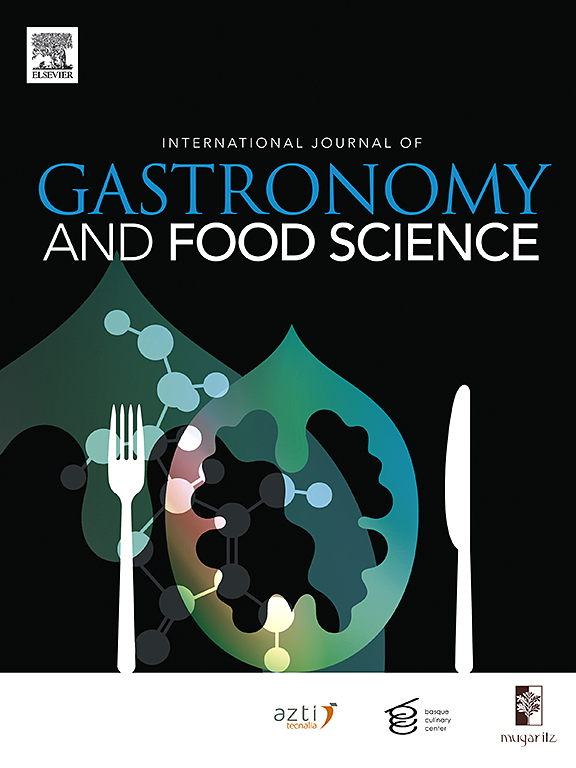具有生产酵母发酵剂技术和生物活性潜力的原生植物乳杆菌和短乳杆菌
IF 3.6
2区 农林科学
Q2 FOOD SCIENCE & TECHNOLOGY
International Journal of Gastronomy and Food Science
Pub Date : 2025-06-11
DOI:10.1016/j.ijgfs.2025.101221
引用次数: 0
摘要
本研究对来自巴西东北部不同气候区的酵母进行了研究,以鉴定乳酸菌(LAB)的本地菌株并评估其技术潜力。从湿润、半湿润和半干旱地区采集酵母样品,分离出129株细菌。其中24株具有典型的LAB特征,通过MALDI-TOF质谱鉴定为植物乳杆菌(Lactiplantibacillus plantarum)、副乳杆菌(Companilactobacillus parimentarius)和短乳杆菌(Levilactobacillus brevis)。湿润气候区以副纹草为主,其他气候区以植物乳草为主。通过主成分分析,从酸化、蛋白水解活性和胞外多糖产量等方面筛选出17株具有较好工艺潜力的菌株。然后对这些菌株进行酸、盐、蔗糖和乙醇胁迫的耐受性试验。L. plantarum 47 (Lp47)具有较强的耐酸、耐盐性。L. brevis 83 (Lb83)对高浓度乙醇具有耐受性。然后将这些菌株用作发酵剂来评估发酵性能。Lp47和Lb83在发酵胁迫下表现出快速的生长和酸化,分别在发酵4和6 h时酸化培养基。两株菌株在发酵过程中均逐渐增强抗氧化活性和酚类化合物的产量,但差异不显著(p >;0.05)。流变学测试表明,添加Lp47和Lb83的酵母在24小时后黏性更低,弹性更强,抗变形能力更强。这些发现强调了Lp47和Lb83作为酵母生产的有效发酵剂的潜力,确保了更快、可控的发酵,同时增强了结构和生物活性特性,特别是在大规模应用时。探索酵母发酵过程的生物技术潜力扩展了我们的理解,并为开发功能性、健康和高价值的食品开辟了新的可能性。我们的研究强调了本地菌株在促进发酵中的重要性。这些菌株加速了生产,提高了效率,提高了面包质量,显示出它们对食品工业产生重大影响的潜力。本文章由计算机程序翻译,如有差异,请以英文原文为准。
Autochthonous strains of Lactiplantibacillus plantarum and Levilactobacillus brevis with technological and bioactive potential as starter cultures for sourdough production
This study investigated sourdoughs from different climatic regions in northeastern Brazil to identify autochthonous strains of lactic acid bacteria (LAB) and evaluate their technological potential. Sourdough samples were collected from humid, sub-humid, and semi-arid regions, yielding 129 bacterial isolates. Of these, 24 strains exhibited typical LAB characteristics and were identified via MALDI-TOF mass spectrometry as Lactiplantibacillus plantarum, Companilactobacillus paralimentarius, and Levilactobacillus brevis. C. paralimentarius dominated in humid regions, while L. plantarum prevailed in other climates. From principal component analysis, seventeen strains with good technological potential were selected based on acidification, proteolytic activity, and exopolysaccharide production. These strains then underwent tolerance tests for acid, salt, sucrose, and ethanol stress. L. plantarum 47 (Lp47) exhibited superior acid and salt tolerance. L. brevis 83 (Lb83) presented tolerance to high ethanol concentrations. These strains were then used as starter cultures to evaluate fermentative performance. Lp47 and Lb83 demonstrated rapid growth and acidification under fermentation stress, respectively acidifying the medium at 4 and 6 h. Both strains progressively enhanced antioxidant activity and phenolic compound production during fermentation, with no significant differences (p > 0.05). Rheological tests revealed that sourdoughs with Lp47 and Lb83 were less sticky, more elastic, and exhibited greater deformation resistance after 24 h. These findings underscore the potential of Lp47 and Lb83 as effective starter cultures for sourdough production, ensuring faster, controlled fermentation while enhancing textural and bioactive properties, particularly for large-scale applications. Exploring the biotechnological potential of sourdough fermentation processes expands our understanding and opens new possibilities in gastronomy and food science for developing functional, healthy and high value food products. Our study highlights the importance of autochthonous strains in enhancing fermentation. These strains accelerated production, improved efficiency, and enhanced bread quality, demonstrating their potential to significantly impact the food industry.
求助全文
通过发布文献求助,成功后即可免费获取论文全文。
去求助
来源期刊

International Journal of Gastronomy and Food Science
Social Sciences-Cultural Studies
CiteScore
5.30
自引率
10.50%
发文量
170
审稿时长
45 days
期刊介绍:
International Journal of Gastronomy and Food Science is a peer-reviewed journal that explicitly focuses on the interface of food science and gastronomy. Articles focusing only on food science will not be considered. This journal equally encourages both scientists and chefs to publish original scientific papers, review articles and original culinary works. We seek articles with clear evidence of this interaction. From a scientific perspective, this publication aims to become the home for research from the whole community of food science and gastronomy.
IJGFS explores all aspects related to the growing field of the interaction of gastronomy and food science, in areas such as food chemistry, food technology and culinary techniques, food microbiology, genetics, sensory science, neuroscience, psychology, culinary concepts, culinary trends, and gastronomic experience (all the elements that contribute to the appreciation and enjoyment of the meal. Also relevant is research on science-based educational programs in gastronomy, anthropology, gastronomic history and food sociology. All these areas of knowledge are crucial to gastronomy, as they contribute to a better understanding of this broad term and its practical implications for science and society.
 求助内容:
求助内容: 应助结果提醒方式:
应助结果提醒方式:


